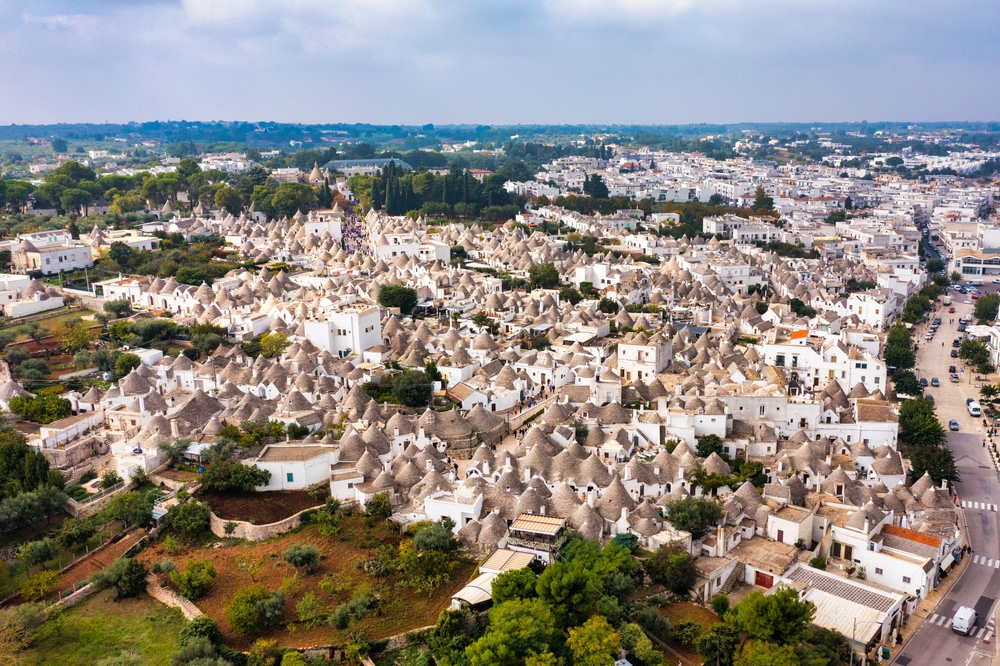
Apulian Trulli: Between tradition and modernity
Mentioning the region would be incomplete without discussing Puglia’s architecture, particularly its renowned white-washed trulli buildings with their distinctive conical shapes, drawing travelers from around the globe.
Often considered integral to the region’s essence, these historic dwellings encapsulate the spirit of Puglia. The feeling one gets is that of stepping into an enchanted realm, where time appears to stand still and where humans have achieved a harmonious architectural blend with the natural surroundings.
Continue reading to delve deeper into their unique architecture and explore theories surrounding the intriguing reasons behind the construction of these distinctive Italian dwellings.
Exploring the Tradition
A trullo, known as trulli in plural form, represents a traditional stone dwelling characterized by its cone-shaped roof. These structures are indigenous to the Puglia region of Italy, particularly prominent in Valle d’Itria, where Alberobello stands amidst verdant landscapes of olive trees and vineyards.
Featuring charming interiors, rustic stone craftsmanship, and an unmatched ambiance, Puglia’s trulli houses offer a distinctive retreat for travelers seeking a blend of luxury accommodations and rich cultural heritage.
The diverse use of stones in trulli construction is captivating, but equally intriguing is the ornamentation of these structures, whether they are completely whitewashed or embellished with traditional motifs. Here are some essential features to observe when discovering trulli.
Their roofs consist of two layers of stones known as “skins.” The inner layer, called “chianche,” consists of wedge-shaped stone voussoirs commonly used in arch construction. The outer layer, known as “chiancarelle,” consists of stones arranged to tilt outward, ensuring a waterproof roof.
The distinctive pinnacles crowning trulli roofs are a testament to individuality and creativity. Predominantly found in Alberobello, these hand-carved stone pinnacles often resemble chess pieces, featuring various designs like stone spheres, cones, disks, and more, intricately stacked to form unique configurations. The sphere is the most widespread form, perhaps because it recalls the archaic cult of the sun or the Christ-sun. Beyond their ornamental purpose, folklore suggests these pinnacles may serve as protective charms against malevolent forces, according to the magical-religious tradition that has always enlivened the otherwise harsh and repetitive peasant life.
How to immerse yourself in the trulli experience today?
In modern times, trulli have been repurposed for various uses, ranging from private residences to commercial establishments. Here are some common ways trulli are used today:
- Private Residences: Many trulli have been renovated and transformed into comfortable homes, offering a unique living experience characterized by their distinctive architecture and historical charm.
- Vacation Rentals: Trulli are popular choices for vacation rentals, especially in tourist destinations like Alberobello. Visitors can experience the traditional Apulian lifestyle while staying in these quaint and cozy accommodations.
- Hotels and Bed & Breakfasts: Some trulli have been converted into boutique hotels or bed and breakfasts, providing guests with an authentic and memorable stay. These establishments often offer modern amenities while preserving the trulli’s original features.
- Restaurants and Cafés: In towns and villages with a significant number of trulli, some have been repurposed as restaurants, cafés, or bars. Dining or having a coffee in a trullo adds to the ambiance and offers a unique setting for patrons.
- Artisan Workshops and Shops: Trulli are sometimes used as workshops or shops by local artisans, showcasing traditional crafts such as pottery, textiles, or woodwork. These establishments contribute to the preservation of local culture and heritage.

Overall, trulli continue to play a significant role in modern life in Puglia, serving both practical and cultural purposes while retaining their historical significance and architectural beauty.
Moreover, events can certainly be held inside trulli! Many trulli have been repurposed to accommodate various events, ranging from intimate gatherings to larger celebrations. Here are some types of events that can be held inside trulli:
- Weddings: Trulli provide a unique and charming setting for wedding ceremonies, receptions, and related events. Couples often choose trulli venues for their romantic ambiance and picturesque surroundings.
- Parties and Celebrations: Whether it’s a birthday party, anniversary celebration, or family reunion, trulli offer cozy and intimate spaces for hosting gatherings with friends and loved ones.
- Corporate Events: Trulli venues can also be used for corporate events such as meetings, conferences, team-building activities, and product launches. The unique setting adds an element of novelty and can make business events more memorable.
- Cultural and Artistic Events: Trulli may host cultural events such as art exhibitions, music performances, poetry readings, and theater productions. These events showcase local talent and creativity while highlighting the historical significance of trulli.
- Workshops and Retreats: Trulli provide serene and inspiring environments for hosting workshops, retreats, and wellness events. Participants can engage in activities such as yoga, meditation, cooking classes, or artisanal workshops while surrounded by the beauty of the trulli architecture.
Overall, trulli offer versatile spaces that can be adapted to accommodate a wide range of events, adding a touch of authenticity and charm to any occasion.


Leave a Reply